Art & Photographic History Section
La Section d'l'Histouaithe d'l'Art et d'la Photographie

Art & Photographic History Section
La Section d'l'Histouaithe d'l'Art et d'la Photographie
"Turnkey" Giffard and the Devil
Jean Philippe "Turnkey" Giffard (1826-1892)
Stonemason, self-taught stone-carver, Prison gardien, Master Mariner and reputed smuggler.Silver medal for plans/model of a fountain, Exposition des Iles de la Manche 1871
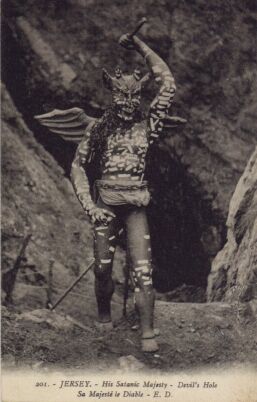
Captain Jean Giffard's greatest claim to fame is as the sculptor of the original Devil at the Devil's Hole - although much of the record we have of his life and work is due to his grandson, George d'la Forge, who left us many stories and references in his writings.
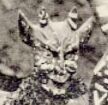
He appears to have been a native of St. Peter's Parish he spent his early days at sea, becoming a Captain in the Merchant Marine, crossing the Atlantic many a time and often the then Newfoundland codfish industry. To beguile the tedium he taught himself wood carving.
notes Philip Ahier

While gardien at the Public Prison, he put up varied statuary to "cheer up the prisoners". He also provided decorations and furnishings for the Troglodyte Caves (opened 1878): "they consisted of statuary, coats of arms, busts, and decorations of all kinds of wood, stone and clay. The main attraction was a life-size statue of the Zulu chief Cetewayo... that of a man complete in every respect... and it therefore became necessary to hang a short skirt around its middle. But the word of the existence of the symbol of its manhood got around, and aroused the curiosity of the ladies, who lifted the skirt to satisfy their curiosity... It was decided to erect a cubicle with an open window to contain the chief's statue... the ladies then used their parasols to lift the skirt!"
Sculptor's grandson, George F. Le Feuvre quoted in Brett, Buildings in the Town and Parish of Saint Helier.

....le fameux Cetewayo
Chronique de Jersey 22/6/1881

Les Caves Troglodytes
...Pour ceux qui songent aux réformes religieuses leurs yeux reposent avec plaisir, sur une grande statue en bois représentant John Knox, un bras levé en haut, sous l'autre, la Bible. Les admirateurs des écrits de Sir Walter Scott trouveront également sur ce terrain une représentation de la Lady of the Lake...
Nouvelle Chronique de Jersey 24/4/1889

Il y a aussi une profusion de statues en terre glaise, notamment celle du célèbre Cetewayo, le Roi des Zoulous, sur lequel il ne manque pas d'anecdotes.
Chronique de Jersey 18/7/1900
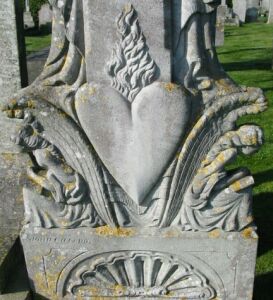
Tombstone of Mlle. Combois, Almorah Cemetery, St. Helier
Sculpture
Jersey possède - caché pour ainsi dire dans la demeure modeste qu'il s'est choisie aux bords de la mer - un sculpteur dont le génie a souvent frappé les connaisseurs, et qui, malgré l'obscurité relative où il est resté depuis quelque temps déjà, - n'en travaille pas moins à son art favori.
Nous voulons parler de M. Giffard, ex-tourne-clefs de la Prison Publique et sculpteur - par goût. - Tous ceux qui ont visité la Prison, ont pu admirer et admirent encore les souvenirs qu'y a laissés Giffard. La belle statue de Samson rompant ses liens - celle du captif à la Torque; le lion blessé - les bustes innombrables qui entourent le jardinet entre le mur intérieur et le préau des débiteurs, - tous accusent la hardiesse et surtout la justesse du coup de ciseau et du maillet du sculpteur né.
D'autres oeuvres existent çà et là dans les maisons particulières et tous font preuve du talent et du bon goût de notre compatriote. Il est à regretter qu'il n'y a pas eu, dans le temps, quelqu'un à pousser cet artiste, car il eut indubitablement doté son pays de quelques chefs d'oeuvre.
Mais - et ces mais sont des obstacles insurmontables - l'homme qui dépend de ses dix doigts pour élever honnêtement et honorablement sa famille - ne peut guère se permettre les distractions d'une étude pratique et combien de coeurs généreux, brûlant de cette flamme divine de l'art - se voient forcés de sacrifier leurs rêves à la pratique brutale de la vie ordinaire.
Tel a été un peu le cas avec notre ami Giffard et, si nous venons aujourd'hui le rappeler aux souvenirs de ceux qui l'ont connu, c'est parce que nous aimons à signaler le mérite partout où il existe et surtout dans ce petit pays chéri où l'amour de l'art a atteint le niveau des pommes-de-terre nouvelles et des blocs de concrète!
Giffard travaille toujours et la pierre prend sous ses doigts habiles les formes les plus charmants. On peut le voir, dans son petit atelier à la Grande Charrière - ciseau et scie en main, découpant la pierre comme du carton, faisant des ciselures charmantes et se déployant un veritable amour pour les oeuvres qu'il crée.
Il travaille dernièrement à une belle croix destinée à orner le tombeau d'une fille chérie - Mlle Combois - dont le père affligé veut consacrer la mémoire. C'est un travail de toute beauté. Au pied de la croix sont deux Anges agenouillés et un coeur enflammé. Une draperie tombe de chaque côté de la croix, dont les bras sont entourés d'une couronne d'immortelles. Le travail est delicat et vigoureux et fera, posé sur un piedestal en granit, un bel effet. Le monument sera placé dans le cimitière Almorah.
Notre sculpteur, sera n'en doutons pas, très-heureux de faire voir cet échantillon de son savoir-faire à tous ceux qui sont connaisseurs et amateurs du beau et du pur.
Chronique de Jersey 30/5/1877
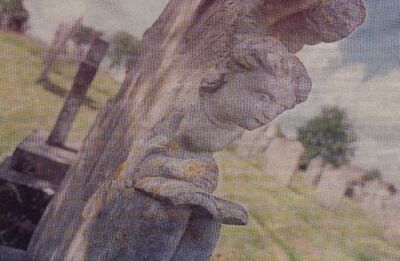
Tombstone of Mlle. Combois, Almorah Cemetery, St. Helier
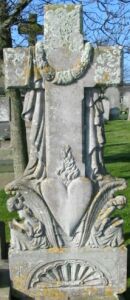
Tombstone of Mlle. Combois, Almorah Cemetery, St. Helier
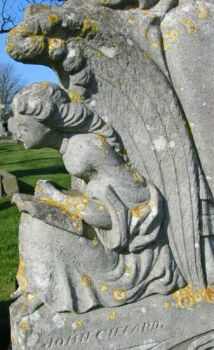
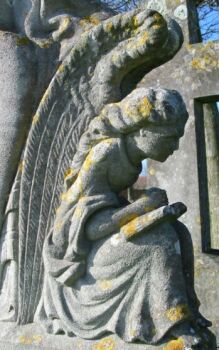
Le guichetier-sculpteur - Nous avons vu une nouvelle oeuvre de M. Jean Giffard, le gardien de notre maison de correction, chez lequel la sculpture est un art inné. C'est un buste du General Don, cet ex-Lieut.-Gouverneur de Jersey qui a tant contribué a la prosperité du pays et auquel jusqu'ici nous n'avons temoigné notre reconnaissance qu'en donnant son nom à l'une des rues les plus inconnues de St.-Helier, et à un bout de la première grande route que ce général fit ouvrir, en dépit de l'opposition formidable qu'il rencontra. On a quelquefois parlé d'élever une statue au Général Don; voilà une belle occasion, puisque nous avons le sculpteur chez nous. Ce serait vraiment de la reconnaissance toute nationale. M. Giffard a, dans son buste, parfaitement réussi la ressemblance, d'après les gravures que nous avons, de notre ex-Lieutenant-Gouverneur.
Chronique de Jersey 9/4/1859

Buste de M. l'Avocat Godfray. — Un buste de Frs. Godfray, écr., admirablement sculpté en pierre de Caen par M. Jean Giffard, guichetier de la prison publique, a été transporté Mercredi à la résidence de M. Godfray, à Quatre Bras, et accepté par la famille de ce monsieur. Ce buste, qui a été exposé pendant quelque temps dans l'atelier où travaille le sculpteur-guichetier, est d'une ressemblance frappant et remarquable par le fini et la délicatesse du travail.
Nouvelle Chronique de Jersey 5/4/1862

Bust of Mr. Advocate Godfray
A bust of Francis Godfray, admirably executed in Caen stone by Mr. John Giffard, turnkey of the prison, was on Wednesday last taken to his residence, Quatre-Bras, and accepted by his family. This bust is a striking likeness of Mr. Godfray, and is remarkable for the finish and delicacy of the work. Mr. Giffard is a Jerseyman, and, in the strictest sense of the word, a self-taught man.
Jersey Times 5/4/1862

Local Talent. — Within the past few days two additional pieces of sculpture have been placed in the court-yard of the House of Correction, Gloucester-street. They are figures of children, expressive of grief, and from the chisel of Mr. John Giffard, who is employed as turnkey in the institution. Mr. Giffard is a self-taught artist, in sculptor at least, and, altough he does not yet move in the professional circle, it must be gratifying to his friends to know that several of his works have met with high approval and commendation. Not very long ago he executed several other figures, which adorn the cort-yard, the most prominent of them being "Sampson, breaking his bonds." Upon the high court wall is an excellent specimen of the Royal Arms (four feet square) with those of Jersey in less assuming character. A fine figure of a lion, a fountain, and other works of art may also be seen close at hand. The whole have been executed in Caen stone. It was at one time contemplated employing Mr. Giffard upon a statue of General Don, to be placed in the Parade; delays, however, intervened, and it is now difficult to say whether the work will be proceeded with.
Jersey Times 22/5/1863

Sculpture. - Nous apprenons que M. J. Giffard, qui s'est fait déjà remarquer par des travaux de sculpture d'un mérite réel, achève en ce moment une oeuvre qui fera apprécier toute l'étendue de son talent. Cette oeuvre représente "Le prisonnier après trente-sept années d'incarceration." On assure que les proportions anatomiques du sujet sont parfaites, et chacun est surpris de trouver une connaissance aussi profonde de l'art chez un homme qui n'a jamais étudié la sculpture sous un maître. Il paraît que M. Giffard va commencer une nouvelle oeuvre non moins remarquable que celle dont nous venons de parler: elle représentera "L'arrestation du prisonnier."
Nouvelle Chronique de Jersey 8/12/1866

There is but little of the "work of men's hands" in Jersey to mark a love of, or a taste for art. Indeed, the exact converse of this is the stranger's usual remark, for although the churches and the old residences have a quaint beauty of their own, modern buildings, furniture, and dress all appear below par. These shortcomings though, it would appear, are more due to lack of teaching and example, than to a want of appreciation of the beautiful. For, apart from Millais, and his less-known brother, both giants in their genres, the Island can boast of the works of several very creditable artists. MONAMY, some of whose marine pieces are in the Gallery of Hampton Court; PHILIP JEAN, celebrated for his portraits and miniatures of the old Jersey gentry; LE CAPPELAIN, whose sense of art was far greater than his powers of execution. And among those living, Falle, Le Bailly, De La Taste, besides many promising smaller fry. GIFFARD, a turnkey of the jail, represents insular sculpture, and is, according to current gossip, a vigorous, though uneducated, interpreter of nature.
A Gossiping Guide to Jersey J. Bertrand Payne 1863

The visitor is struck on entering the precincts of the gaol with the exquisite taste displayed in the laying out of the grounds. The plate-bande in front of the building is one mass of geraniums and other showy flowers, while on all sides are statues admirably sculptured in Caen stone by one of the former warders, a self-taught artist. A fountain and basin containing gold and silver fish enlivens the place; and towering over all is a large statue of Samson breaking his bonds, the chef-d'oeuvre of the above-mentioned native artist. The whole is due to the taste and energy of Mr. John Le Rossignol, the gentlemanly and urbane governor of the Establishment. In the front garden, the lover of horticulture may feast his eyes on a rare display of choice flowers; and but for the frowning walls and chevaux-de-frise, one might well fancy himself in a pleasure garden.
Perrot's Guide 1869
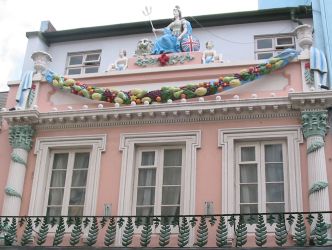
La Grappe dé Vèrjus - restored 2001
The Lamplighter
This pub was originally known as Daly's Hotel, from its proprietor, later it became known as "La Grappe de Verjus" and then "The Grapes".
The original facade of the hotel was one of the most picturesque and imposing in the town of St. Helier previous to the alterations effected in 1960.
Very few pedestrians who walked up and down Mulcaster Street could not fail to admire (if they noticed it) Captain John Giffard's monumental piece of work - the representation in wood and lead upon what was known to the country folk as "La Grappe de Verjus"....
The following is an inadequate description of the former facade:-
At its vertex can still be seen a statue of Britannia seated on her throne, trident in hand; on her right is the recumbent lion while on her left is the elliptical shield containing the Union Jack.
Below this ornamentation (which still remains) were the two cupid boys usually associated with the God Bacchus. These are now placed one each side of Britannia. In a line with the boys, on opposite sides of each, were two urns from which dangled a garland of replicale of fruits from which wine, perry, cider and other alcoholic beverages are made. Below the two urns were the semi-circular columns; on each were representations of acanthi superimposed with bunches of grapes. Between those columns stood a man and woman typical of workers in a vineyard; the man was depicted as squeezing the grapes while the woman held a tumbler to receive the juice.
Descending to the ground floor (as it were) were three decorated semi-circular columns ornamented with grapes, hence the local expression, "la grappe de verjus", but the piece de resistance was the two grotesque heads with decayed teeth, protruding tongues and bleary eyes, standing on either side of the main entrance to the hotel. The heads looked so debauched that Captain Giffard must have inserted an ironical touch in the design of the facade. They were removed in 1960.
The Historical Hotels and Inns of Jersey Philip Ahier and W.S. Ashworth

La Grappe dé Vèrjus
Ma m'mée 'tait la fille à Cap'taine Jean Philippe Giffard (1826-1892). I' mouthit quand j'n'avais qu'un an, et j'ai tréjous r'gretté dé n'l'aver pon connu. Il 'tait stchulpteux. Ch'tait li tch'avait stchulpté l's armueûthies d'Angliétèrre tchi sont en d'ssus d'la côtchiéthe dé la prîncipale maîson dans l'bel dé la prison en Ville. Il avait stchulpté toutes sortes d'choses et d'înmages, mème eune statue du chef "Citiwayo" des Zoulous en Afrique, qué nou viyait ès Caves dé Champion à La Crouaix d'Bouais quand j'tais mousse. Et ch'tait li tch'avait fait l'preunmié dgiâbl'ye tchi faîsait la garde dans l'Creux du Vis (mênommé l'Creux au Dgiâbl'ye) à Ste. Mathie.
Jèrri Jadis George F. Le Feuvre
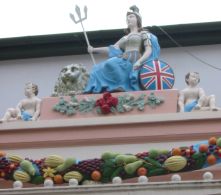 |
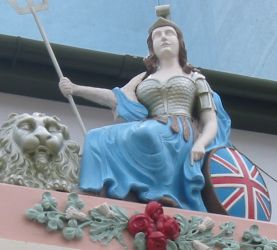 |
La Grappe dé Vèrjus
Acouo un p'tit pus liain dans la gâzette, je v'nons à chein tch'est, pour mé, "la pièce de résistance". Ch'est l'annonce dé la restaurâtion et les portraits d'l'aubèrge appelée "The Grapes" dans La Rue Mulcaster en Ville. Lé "Turnkey Giffard" tchi stchulptit les grappes 'tait man grand-péthe matèrnel John Philippe Giffard, tchi stchulptit un tas objets dans l'bel dé la Prison. L'almonas d'"La Chronique de Jersey" dé 1859 lé mentionne comme "Gardien" dé la Maîson dé Correction, et sa femme Mary Giffard comme Matrone. I' sont acouo là en 1865 et 1867, mais chutte fais Papa Giffard est mentionné comme "Guichetier" dé la Prison.
John Philippe Giffard mouothit en 1892 et fut entèrré dans l'chînm'tchiéthe dé l'églyise parouaîssiale dé St. Pièrre. Né en Jèrri, il 'tait provenu dé ieune des fanmil'yes Giffard d'Angliétèrre. Ma m'mée m'disait dans san vivant tch'il avait deux fréthes tch'étaient architectes à Londres. Il 'tait bein connu comme stchulpteux en Jèrri dans san temps et ch'tait li tch'avait stchulpté la grand' partie d's objets tch'ornaient les Caves dé Champion (mênommées "Troglodyte Caves") à La Crouaix d'Bouais.
George F. Le Feuvre 7/5/1983

Y'a un bieau portrait d'la côtchiéthe dé la vielle prison dans la gâzette du treize dé mar tchi montre l's armueûthies d'la Couronne en d'ssus d'la grand'porte du mitan. I' fûdrent faites par man Papa, l'Cap'taine (et stchulpteux) John Philippe Giffard. J'sis bein content d'vaie qué l's architectes sont d'avis qué l'bâtisse èrprésente la pus belle architectuthe dé Jèrri et qu'ou vaut la peine dé consèrver. S'il est possibl'ye dé dêtachi l's armueûthies d'la côtchiéthe sans l's endommagi quand l'bâtisse s'sa démonté ou abattu, j'ai d'mandé ès autorités dé m'les donner pour les garder au Ménage ès Feuvres en mémouaithe dé Papa Giffard.
George F. Le Feuvre JEP 15/5/1975

V'là tchi m'fait grand pliaîsi d'vaie qué, grâce au fanmeux discours qué l'Député P.M. de Veulle fit dans L's Êtats l'aut' jour, et la généthôsité et l'bouan sens d'La Chambre, l's autorités s'en vont présèrver la côtchiéthe dé la vielle prison. Dans un mangnifique articl'ye dans la gâzette du trais d'octobre, lé Sieur Robin S. Cox nouos dit "tch'il est dit" qué l's armeûthies Rouoyales en d'ssus d'la date 1812 sus lé d'vant d'la côtchiéthe avaient 'té faites par lé "Guichetier" Giffard. Eh bein, i' n'y' a pon d'doute au sujet. Y'a tchiques années, Moussieu Moon, lé Gouvèrneux d'la prison, m'dit qu'iun d'ses empliyés avait mînt eune êtchelle en pliaîche et tch'il avait examinné l's armeûthies d'près, et qu'la sîngnatuthe du Sieur Giffard 'tait d'ssus, et la date dé l'année étout.
John Philippe Giffard, pus tard "Cap'taine" Giffard, 'tait man grand-péthe matèrnel. Il 'tait un fanmeux stchulpteux, et ch'tait li tch'avait fait toutes les stchulptuthes dans les caves dé Champion, mênommées "The Troglodyte Caves" à La Crouaix d'Bouais, à St. Sauveux. Et ch'tait li tch'avait fait l'estatue dé "Citiwayo", Chef des Zoulous, tch'était là étout.
George d'la Forge JEP 17/10/1975

"En pâlant d'faches dé bouais," j'dis à Papa. "Papa Giffard en faîsait, li, en bouais. J'avons la tête dé la Reine Alexandra, tch'i' stchulptit, dans l'gardîn et oulle est si bein faite qué nou dithait qu'oulle est en vie. Et quand j'allis à St Pièrre vaie l'dgiâbl'ye tch'il avait stchulpté pour mett' dans L'Creux du Vis, la fache pathaîssait quâsi en vie étout."
"Vaithe, man garçon", i' m'dît, "tan Papa Giffard 'tait un homme absolûment doué. Ch'est danmage qué tu n'l'as pon connu, car tu n'avais qu' un an quand i' mouothit en l892. Quand j'éthons la chance, j't'emmèn'nait ès Caves dé Champion à La Crouaix d'Bouais. Là, tu vèrras un tas d'ses stchulptuthes. Et y'en a un tas dans l'bel dé la Prison en Ville. Tch'est tchi sait, j'pouôrrais p't-êt' aver pèrmission dé t'montrer ches'là étout. I' faudra qu' j'en pâle au Connêtabl'ye d'Auvergne."
George d'La Forge 9/7/1983

Ma connaissance dé Papa Giffard n'est qué chein qu' M'mée m'racontit, car j'n'avais qu' tchînze jours quand i' mouothit. Lé Cap'taine Giffard 'tait machon et stchulpteux. Il ouvrageait des poupettes en bouais pour les d'vants des batchieaux à vaile. I' fit étout des lions en pièrre, d'la grandeu d'l'annima même, tchi fûdrent pliaichis dans l'bel d'la Prison. Ma femme, la chiéthe May, et mé les vîtent quand j'visitînmes Jèrri duthant la preunmié dgèrre. Papa Giffard avait 'té chef gardgien là pour des années.
D'autres de ses stchulptuthes comprannaient un Venus dé Milo en pièrre, expédiée à Londres, eune statue du Dgiâbl'ye, en bouais, pliaichie à La Touothaille, en Jèrri, où'est qu'ou restit jusqu'à 1930 ou d'même, et des stchultuthes sus lé d'vant d'eune storre dans la Rue Mulcaster. Sa dreine oeuvre 'tait eune statue en pièrre, en grand, dé deux anges auves des ailes, jouant la trompette. Il avait idée d'aver chutte statue-chîn pliaichie sus sa sépultuthe dans l'chînm'tchiéthe dé l'Églyise dé St. Pièrre mais, duthant l'transport, la reue du tchéthiot rompit et la statue tchit et d'pichit. M'mée dit tch'il avait prîns longtemps à finni chutte tâche-là et 'tait si dêsolé entouor sa pèrte qu'i' tchittit d'stchulpter.
Un jour, justément d'vant tchitter St. Pièrre, deux méssieurs en câsaques à pannieaux vîndrent en cârrosse et pâlîdrent à M'mée pour eune volée. En sortant i' s'êssuyaient les lèrmes des ièrs, M'mée m'dit tch'i' 'taient les deux p'tits fréthes à Papa tchi v'naient justément d'arriver d'Londres et n'savaient pon qué Papa 'tait mort. Né v'là la dreine fais qué j'les visse ou qu' j'en ouisse pâler. S'lon M'mée, san grand-grand-péthe patèrnel 'tait architecte à Londres et avait mathié la Comtêsse dé la Motte (eune seule êfant) d'eune fanmil'ye d'aristocratie Nouormande. I' la dêconnûtent pour aver mathié parmi lé m'nu peupl'ye et la forteune dé la fanmil'ye êtchit au Gouvèrnément Français.
Papa Giffard avait 'té mathié auve Mary Susan Lé Boutilyi dans l'Êglyise dé St. Sauveux, en Jèrri, par lé Douoyen L'Bréton (lé péthe à la fanmeuse Lillie Langtry). Enfîn, M'mèe n'avait qu' deux ans quand sa m'mèe Susan mouothit, et la deuxième femme à Papa, née Lé Clièr, 'tait la manman qué j'connaissais et aimais comme mousse quand jé d'meuthions dans la belle blianche caûminne dans la Vallée d'St. Pièrre.
La vie et l's amours d'un Jèrriais transplianté Sidney George Le Feuvre JEP 5/12/1986

The "Devil Has a Night Out!
Found "Incapable" Outside "Evening Post" Building
Last night - a perfect summer one and only 48 hours before the full moon - the Devil thought he would take a jaunt in the bright moonlight and enjoy a night out. The point was where he should go, and he pondered over this on leaving his dug-out at the Devil's Hole, St. Mary.
Suddenly he thought of the very place. He, the Devil, was just the fellow to take a "hot" piece of news to "The Evening Post", so off he set for St. Helier and made a fairly quick and successful journey. But on arrival in town he felt rather tired and, on reaching Charles Street, decided that he would take a rest and accordingly "tied himself to a traffic post outside of "The Evening Post" building, where he could rest awhile before visiting his reporter friends, and imparting his "red-hot" gossip.
The Devil, however, never got into the newspaper building, for in the early hours of the morning - at four o'clock to be precise, and before he awoke - the bakers arrived at Messrs. Robinson's to commence their duties, and they saw what they took to be a figure leaning up against "The Evening Post" wall and thought at first glance it was a drunken woman. At that time an officer of the law, in the person of P.c. W. Renouf, came around the corner on his beat and was told of "the drunk". He immediately went up to effect an arrest, and was more than shaken when he was suddenly confronted, not by a drunken woman, or anyone under the influence for that matter, but by a fierce-looking devil in his loin cloth.
Still, duty is duty, and P.c. Renouf gallantly effected an arrest, and put through a call to the Police Station. In a short time the police van arrived, and the officers of the law lifted the Devil up and carted him off to the Station, where he was "detained" while enquiries were made.
Actually the whole thing was started by some practical joker.
A large effigy of the devil is kept at the Devil's Hole - for many years it was at the bottom of the great cave - in a dug-out where people - mostly visitors - pay to pop down and see him. Last night some practical joker decided that it would be fun to take the effigy, and accordingly broke the lock on the dug-out and took it away, apparently carrying the effigy to a car in which they drove to St. Helier and deposited it as told in our story.
The owners of the Devil, Mr. and Mrs. P.N. Arthur, of the Devil's Hole Café, St. Mary, were pleased their "friend" had been found, safe and sound, and they, like everyone else, had a good laugh over the whole incident.
100 years at St. Mary's
Incidentally the Devil has been a feature of this unique spot at St. Mary since 1851, and this apparently was his first visit to St. Helier. He must have felt that 100 years was too long in one spot, and that a change of scenery would do him good
Evening Post 17/7/1951

The "Devil" is Back
Found at Noirmont Point
The "Devil" is back at the Devil's Hole after having been "absent without leave" since Saturday night. Where the effigy was until it was found yesterday afternoon looking out to sea from Noirmont Point is not known, for it is hardly credible that it was at Noirmont all day Sunday.
The effigy was found by a taxi-driver, Mr. Laine, who, in the course of an Island drive with a party of visitors yesterday, called at the Devil's Hole and found that the presiding genie was not at home. Continuing the drive Mr. Laine took his party to Noirmont and there found "his Satanic Majesty" taking the air on the point overlooking the passing craft.
Mr. Laine took the effigy, which had one arm loosened and a foot slightly damaged, back to Mr. Arthur at the Devil's Hole during the evening.
Evening Post 23/9/52

Sa promenade?
L'effigie du diable disparut de son emplacement ordinaire au Trou du Diable en la paroisse de Ste Marie. Elle fut retrouvée 48 heures plus tard à Noirmont.
Chroniques de Jersey 24/9/1952
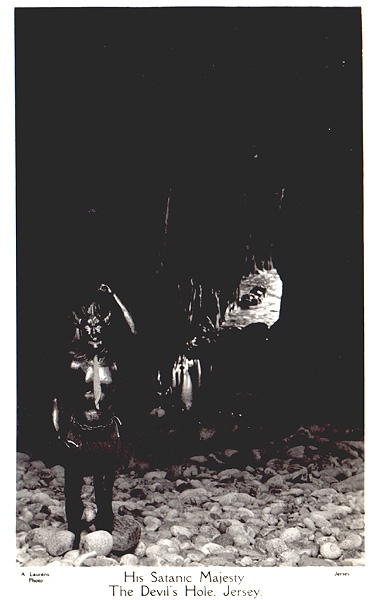
Postcard reproduced courtesy of John Elsbury: |
The cutter La Josephine from Paimpol, Capitaine Nedelec, left Cherbourg for St. Malo with a cargo of colza oil and struck the north coast of the island at the base of a high cliff known as La Creux à la Congre.
At the time of the accident no one on board the ill-fated vessel had any idea that it was so close to the shore. In the afternoon of that day, the Captain had rounded Sark and set his course for Jersey but the currents of which he knew nothing drifted the cutter to the northern coast.
It was quite dark at the time and the crew of five clung like grim death to the rigging of the vessel expectantly awaiting daylight, but in the night the force of the wind and the waves rose to such strength that the shipwrecked mariners thought they would be engulfed at any moment.
One of their number, the mate, Constant Pétibon, the son of the owner of the vessel (not the son of the Captain), thought he espied land, and being a good swimmer, decided to try to reach it. Full of confidence, he flung himself into the sea, and commenced to swim shorewards, while his companions awaited with much anxiety the result of this courageous adventure.
After an interval of time, the young man shouted to his companions that he was close to land but as the coast was so steep he could not get a foothold. He made one more bid but unfortunately perished in the attempt.
The others succeeded in reaching an uncovered rock to which they also held fast fearing each moment that they would be carried away by the waves.
Early next morning, Mr. Jean Richardson, of St. Mary, while proceeding to the coast, spotted the ship-wrecked mariners to whom he gave instructions what to do whilst he returned to his house to get them food as well as to find persons to come to their assistance.
On his return he was able by means of long ropes to supply them with food and drink. As it was then low tide, their situations had become less perilous.
These seamen were... ultimately rescued by Mr. N. Arthur at the bottom of La Creux de la Touraille. In this cavity, likewise, a portion of the wreck drifted and... the figure-head of La Joséphine was rescued and is now incorporated in the "Devil". The body of Constant Pétibon, son of Yves Pétibon, was washed up at Les Laveurs in St. Ouen's Bay a few days later....
The French vessel was wrecked (as the contemporary newspaper reports said) but the figure-head went through the "tunnel" of the Hole. "Someone had a brain wave," said Mr. P.W. Arthur (grandson of Nicholas Arthur) "and called in Captain John Giffard, a well-known sculptor in his day from St. Peter's Valley, to add the arms, legs etc. to the torso and thus the "devil" came into existence!"
Stories of Jersey Seas, of Jersey's Coast and of Jersey Seamen Philip Ahier

Wreck of Joséphine:
Lé Creux du Vis, appelé Lé Creux d'La Touothaille dans les touos vièrs temps viyant tch'il est dans l'fond d'eune crévasse faite comme un vis ou eune touothaille, m'a tréjous întérêssi viyant qu'la preunmiéthe estatue du dgiâbl'ye, en bouais, avait 'té en partie faite par man grand-péthe matèrnel, lé Cap'taine Jean Philippe Giffard, tch'était stchulpteux, dans l'temps tch'i' d'meuthait au bas du Mont d'Ste. Mathie dans La Vallée d'St. Pièrre...
I' n'y'eut pon fort dé débris du naûfrage tchi vînt à tèrre, mais la poupette du navithe fut trouvée. Oulle 'tait v'nue à fliot l'travèrs du creux au bas du Vis, et i' pathaît qu'oulle avait eune èrsembliance au Satan, et tchitch'un eut l'idée d'aver man Papa Giffard à v'nîn la vaie. I' fallait tch'i' fûsse dé la mème idée au sujet d'la r'sembliance au dgiâbl'ye, car il emmenit la poupette siez li et lî mînt des bras et des gambes et un pid fourtchi, et des cornes et eune coue auve eune èrchelle au but, et né v'là un vrai dgiâbl'ye en bouais pret à faithe la garde dans L'Creux du Vis, et j'pense bein qué v'là tchi fit les gens l'appeler L'Creux au Dgiâbl'ye viyant tch'i' l'viyaient là!
Malheûtheusement, j'n'avais qu'à peine treize mais quand Papa Giffard mouothit lé 24 d'octobre 1892, et jé n'l'ai don pon connu, mais Papa et Manman L'Feuvre m'ont souvent dit quand j'tais mousse tch'il' avaient veu l'dgiâbl'ye dans s'n appentis dans La Vallée d'St. Pièrre dans l'temps tch'il 'tait à lî mettre les bras et aut's membres en pliaiche. Il 'tait un supèrbe stchulpteux.
Histouaithes et Gens d'Jèrri George F. Le Feuvre

Il avait des cornes sus la tête, et un visage comme un bichot, et iun d'ses pids 'tait fourtchi comme les pids d'eune vaque, et il avait eune longue coue auve un barbet au but, et san corps 'tait couvèrt dé pé comme eune biche. Ch't' înmage-là d'li 'tait d'autant pus réel dans m'n idée viyant qué ch'tait man papa Giffard tch'avait sculpté l'Dgiâbl'ye en bouais tch'était dans l'Creux au Dgiâbl'ye, et papa L'Feuvre m'avait emmené l'vaie un Dînmanche viyant qu'j'avait 'té bouan garçon.
George d'la Forge
JEP 22/10/1969

Man Papa, Cap'taine Jean Ph'lippe Giffard, en avait fait eune estatue, du Dgiâbl'ye, tch'était visibl'ye dans l'fond du Creux d'Vis (mênommé "Devil's Hole"), et v'là tchi donnait eune idée ès mousses dé s'n appathence. Il avait des pids en chabots fourtchis, eune longue coue atout un didget barbelé au but, et des cornes sus l'haut d'la tête comme un bichot.
George d'la Forge
JEP 15/4/1981

"Tan Papa Giffard en a fait iun en bouais, un Satan, cornes, coue auve lé barbet au but, pid-froutchi et toute la pêque. Il est mâté dans l'tout bas du Creux du Vis et un tas d'monde vont l'vaie. Ch'est p't êt' pour ch'la qué l'creux c'menche à êt' appelé l'Creux au Dgiâbl'ye. Si tu'es un bouan garçon, j'ithons l'vaie ensembl'ye tchique Dînmanche l'arlévée."
George d'la Forge
JEP 22/6/1972

"Lus m'mée, n'est-alle pon eune Giffard?" Jeanneton li dit.
"Oui," Manman li dit, "Florence Mary Giffard, la fille du Cap'taine Jean Giffard, lé sculpteur tch'a fait l's armeuêthies d'Angliétèrre en d'ssus d'la grand' porte dans l'bel dé la prison. Et ch'est li tch'a fait l'estatue du dgiâbl'ye tch'est dans l'fond du Creux du Vis qué l'monde ont c'menchi à appeler l'Creux du Dgiâbl'ye."
"Ch'est rein qu'dépis qu'chu dgiâbl'ye-là a 'té mîns en pliaiche qué l'monde l'appelle dé même," s'fit Jeanneton. "J'allis l'vaie y'a tchique temps, et il est si affreux atout ses cornes qué j'en avais quâsi peux."
George d'la Forge
JEP 14/6/1973

Devil taken from its cage
Thrown into sea at Bouley Bay
During the week-end the Devil was removed from its cage at the Devil's Hole, St. Mary, and taken to Bouley Bay, where it was thrown into the sea.
People making a noise were heard at Bouley bay at about 2.30 yesterday morning, and at daylight, the figure of the Devil was found floating in the harbour there. It had been secured by a rope to the railings at the end of the pier. The matter was reported to Centenier E.R. Mourant, of Trinity.
In the meantime, the manager at the Devil's Hole pavilion had found that the Devil had been taken from its cage, the iron bars of which had been prised apart with a crowbar. The figure had been wrenched from the stand to which it had been nailed, the two feet and one hand being left behind.
Only the body was tied to the end of Bouley Bay Harbour, but the head was seen floating on the tide. This was secured by Mr. Martyn Chatel, a member of the Jersey Sub-Aqua Club, who was at the bay with other members of the club and who brought the head back to the harbour. The body was towed round to a position below the crane on the pier and then lifted up.
The figure taken was that of the Devil which had been at the Devil's Hole for a few years. A previous one was brought into town by hooligans and left outside the main doors of the printing department of "The Evening Post" offices. On that occasion, the figure was returned to its owner. It was later stolen again and presumably destroyed.
Anyone able to give information concerning the week-end incident is asked to contact Centenier Mourant...
Evening Post 22/9/1963

Dans chu temps-là (j'pâle dé y'a huiptante-chînq ans) nou criyait qué l'Satan hantait les c'mîns la niet, et nou n'éthait janmais pensé dé d's'obéi ès pathents dé peux tch'i' fûsse învité à v'nîn nouos qu'si. Man Papa, Cap'taine Jean Ph'lippe Giffard, en avait fait eune estatue, du Dgiâbl'ye, tch'était visibl'ye dans l'fond du Creux d'Vis (mênommé "Devil's Hole"), et v'là tchi donnait eune idée ès mousses dé s'n appathence. Il avait des pids en chabots fourtchis, eune longue coue atout un didget barbelé au but, et des cornes sus l'haut d'la tête comme un bichot.
George d'la Forge JEP 15/4/1981
Newspaper references:
|
Nouvelle Chronique |
10/11/1855 |
|
Chronique |
9/4/1859 |
|
Jersey Times |
5/4/1862 |
|
Jersey Times |
22/5/1863 |
|
Nouvelle Chronique |
8/12/1866 |
|
Nouvelle Chronique |
15/7/1871 |
|
Nouvelle Chronique |
19/7/1871 |
|
Chronique |
22/6/1881 |
|
Nouvelle Chronique |
24/4/1889 |
|
Chronique |
30/5/1877 |
|
Chronique |
18/7/1900 |
|
JEP |
15/5/1975 |
|
JEP |
3/10/1975 |
|
JEP |
24/10/1975 |
|
JEP |
17/10/1975 |
See also: